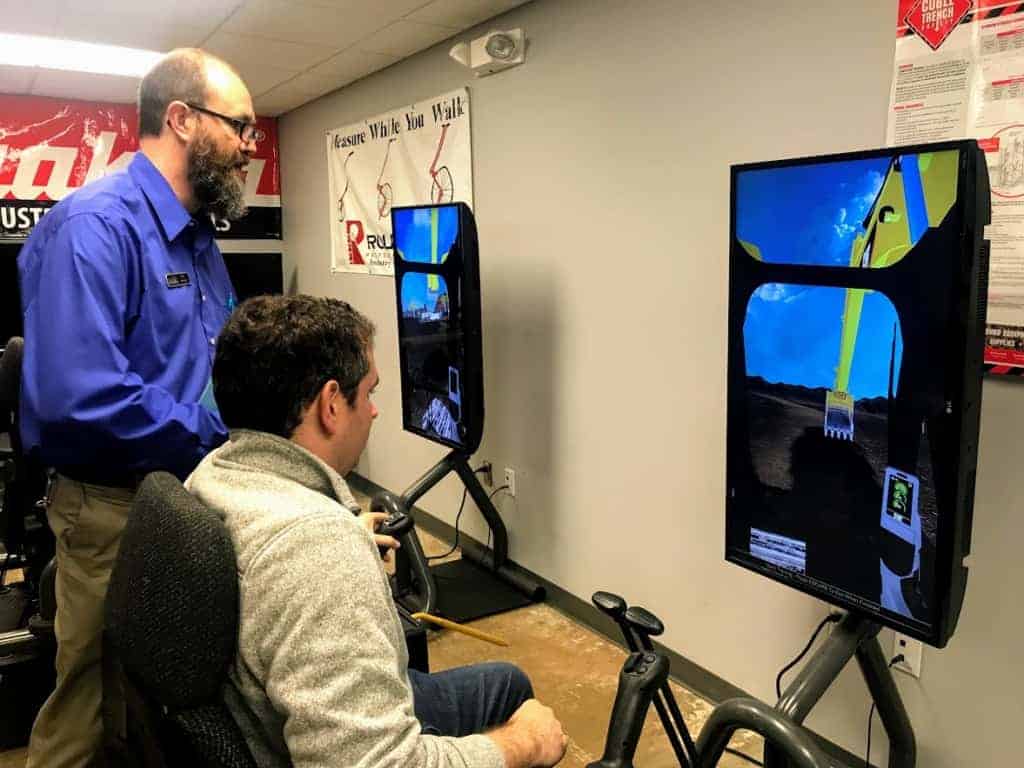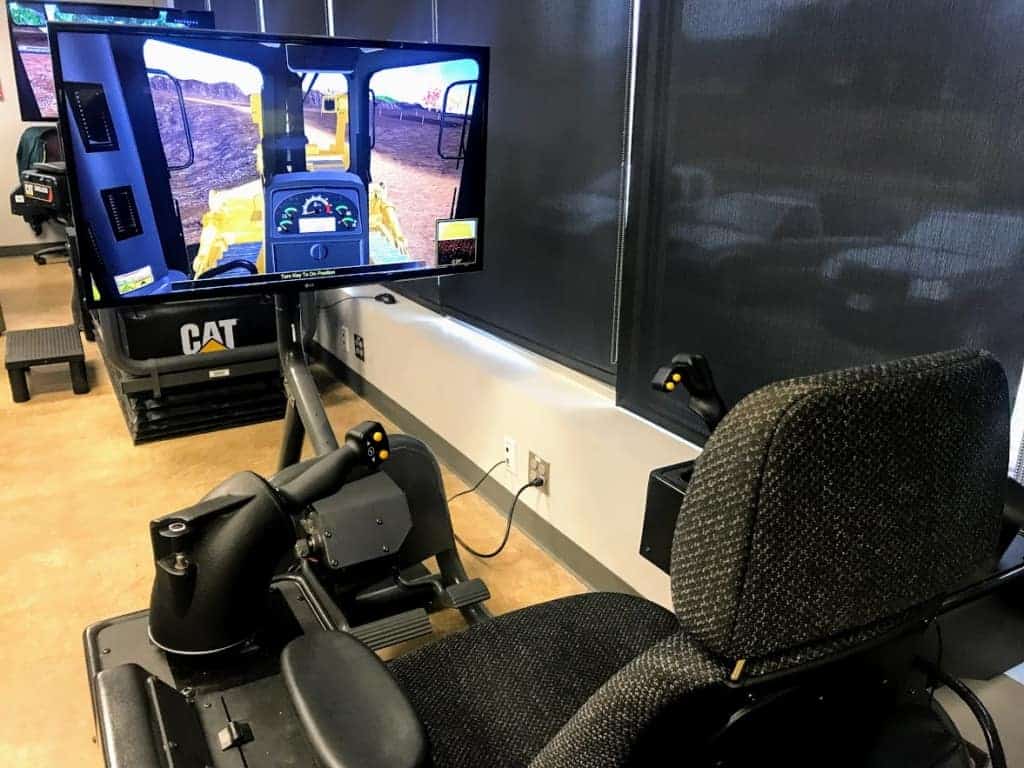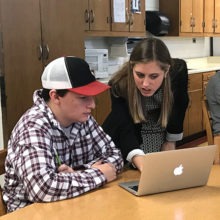If you’ve ever driven past an excavator digging a trench on the side of the street and thought ‘I bet I could operate that machine,’ think again. On a recent visit to Stanly Community College (SCC), we learned just how hard it is to operate heavy equipment like that — and just how important it is to have adequate training. Luckily, students in Stanly’s heavy equipment operations program can train on heavy equipment simulators before stepping into the actual machinery.
In SCC’s advanced manufacturing center, programs like heavy equipment operations, collision repair and refinishing technology, and welding demonstrate how the college is preparing their students to enter the workforce. All three programs are using advanced technology, like simulators and virtual reality, to give students more hands-on experience before working with the real equipment. Program instructors credit this technology with helping students better hone their skills and saving money on practice material.
Heavy equipment operations
Located about an hour outside of Charlotte, SCC regularly sends graduates of its heavy equipment operations program to work in the Queen City’s growing construction industry. On its program website, SCC displays EMSI occupation employment data on the number of jobs available in heavy equipment operations in the area (3,431 in 2018), median income ($17.89 per hour), and job growth (3,705 jobs by 2023).
In addition to construction, graduates work for state and local government agencies and even open their own small businesses. Jacob, a student in the heavy equipment operations program, wants to buy his own piece of equipment one day. “I really didn’t know what I wanted to do,” he explained, “and I live local and I thought [heavy equipment operations] was pretty neat.”

According to Joshua Aldridge, heavy equipment operations program head, SCC is one of two programs in the state that has heavy equipment training and the only one that has an actual live site — an area of about 15 acres behind SCC’s campus where students get to practice with the real equipment.
SCC started the program as a continuing education program in 2009 and added a diploma program in 2013. While there was a diploma program “on the books,” Aldridge said, they decided to redesign it to make the nine-month program reflect actual work environments.
“Before it was more like, you go to class on this machine, you go to class on this machine, and doing that is great but you never learn how to work together as a core crew just like you see out in construction,” Aldridge explained. “So that’s why we changed it up and made it so we work a little like a crew.”
Students can get a diploma in nine months and start work right away. The salary depends on the type of work, Aldridge said. Working with coal ash, for example, pays more but also requires a higher level of training due to the fact that coal ash does not behave the same way as dirt.

SCC got its first equipment simulator in 2009 when the program started, and they have since added new ones as major companies like Caterpillar have updated their equipment. SCC has received grants from the Golden LEAF Foundation and the Cannon Foundation to cover the cost of the equipment. According to Aldridge, just one of the simulators costs about $50,000. Adding a motion platform so the seat moves the way the real equipment does costs another $20,000.
Collision repair and refinishing technology
Uri Osorio grew up in Montgomery County about 30 minutes from Stanly Community College. After deciding he wanted to pursue a career in automotive repair, he researched programs online and came across the collision repair and refinishing technology program at SCC.
“I wanted to get into a program like this,” Osorio explained. “There’s one in Randolph County which is two years. I work in the afternoons part-time, so I needed something where I could work and pay my own expenses. This works out way better for me.”
Osorio loves the hands-on experience he gets through SCC. Billy Huneycutt, the program head of collision repair and refinishing technology, makes sure his students get out of the classroom and into the shop. “In Mr. Billy’s program, he shows us hands on,” Osorio said. “We’re always hands on. I see that as a benefit for us because we’re not in the classroom just workbook workbook workbook.”
Part of their hands-on experience involves learning to paint car panels. Before they can use real paint, however, students must practice and achieve a certain score using the virtual reality paint gun.
“What we require in our program is they have to get up to a score of 90,” Huneycutt explained. “This scores them on everything they do: their gun technique, their speed, their distance, their gun angle. … Once they reach 90, they go into the real paint booth. That saves us on money for paint. … They can stand out here and do it, so they don’t have to wear a paint suit or respirator.”
Osorio is in his second semester at SCC and plans to graduate in July. “When they leave from here they are pretty much set,” Huneycutt said. “One year’s time and they are ready to go into the industry.”
After graduating, SCC students go on to work at automotive repair shops where they can earn $60-75,000 as an entry level technician depending on the amount of work they get, said Scott Pohlman, apprentice supervisor at Service King. SCC’s collision repair and refinishing technology program website says there were 2,293 job openings in 2018 with a median salary of $24.42 an hour.
Pohlman described the need for skilled automotive technicians. “Part of the training that I got [through Service King] was some mind-blowing numbers about how many guys like myself are aging out. So the workforce isn’t being replenished, and they know it. The last number that I received was 21,500 plus technicians are aging out. … The problem is there’s nowhere near that number getting in.”
Service King, a national collision repair company, is feeling that need. Pohlman said when he checked the numbers that morning, Service King had 353 open spots across their 350 stores in 24 states. To deal with this problem, Service King recruits students from Huneycutt’s program to join their apprenticeship program, which is one year of mentorship with an experienced technician after which they become entry-level technicians.
Alan Long is the manager of a Service King that currently employs SCC graduates from Huneycutt’s program. He said when they start the apprenticeship program, they make about $14 an hour. By the time they finish they are making $16 an hour. As full technicians, they then work on commission, meaning their salary ranges depending on how much business they have and how much they work. Long said entry-level technicians make around $60,000 a year, increasing to $80,000 for an average technician. Pohlman said he and other experienced technicians make six figures a year.
“I don’t know of another field that you can come out of with a year [of school] and within five years make $100,000,” Long said. “I have technicians making $170,000. I have some technicians making $80,000. The ones that want to work 60 to 70 hours [a week] can make six figures no problem.”
Welding
The welding program has also embraced virtual reality to help train students. In the video below, MC Pilon of the John M. Belk Endowment is wearing the virtual reality headset and practicing a weld while William Beaver, welding technology program head, gives her feedback on the speed and angle based on the computer graphic. After she finishes the weld, the computer will analyze her speed and accuracy and give her feedback so she can make adjustments.
Beaver echoed the cost-saving factor of using virtual reality, pointing out that no metal was actually used in this process.
Welding is another high demand job suffering from an aging workforce. Beaver explained how the current generation of welders is aging out with few younger welders to replace them: “Unfortunately, we’ve skipped two generations of the transfer of knowledge,” he stated.
Students can enroll in a one-year welding program and receive a diploma in three semesters. According to the EMSI data on the program website, there were 3,610 open welding jobs in the area in 2018 with a median income of $19.75 an hour.
While Beaver can only enroll about 12 students at a time in his program due to space constraints, they have taken the welding simulator to high schools in the area and allowed them to gain exposure to welding as a career.
Editor’s Note: EducationNC receives funding from the John M. Belk Endowment.



